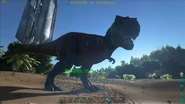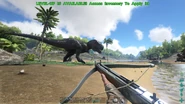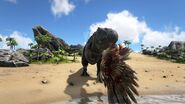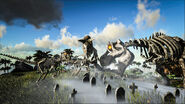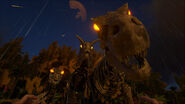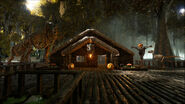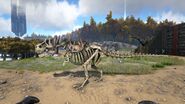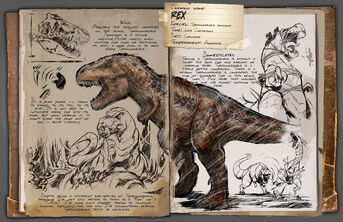
| “ | Wild
Amongst the deadliest creatures on the island, Tyrannosaurus Dominum is a killing machine. Active most when hunting for food or defending it's nest, a reasonable plan is to avoid every Tyrannosaurus. I've seen no creature on the island that can contest Tyrannosaurus for sheer dominance. It is pure power- from its bite, to its stomp, to its tail, to its arms. Despite being a different sub-species of Tyrannosaurus, everyone I've met still refers to them as "Rex" or "T-Rex". I've long since stopped trying to convince anyone, especially the insane few I've seen wearing Tyrannosaurus teeth as necklaces. Domesticated Taming a Tyrannosaurus is no doubt a primary goal for any aspiring warlord or warring tribe. There is a reason the Tyrannosaurus is considered the king of dinosaurs (or with this genus, the "lord"). A tribe that actually manages to tame one has almost nothing to fear to challenge their power. |
” |
— The Dossier
|
The Tyrannosaurus Dominum, more commonly known as the Tyrannosaurus Rex, T-Rex, or Rex, is a large carnivorous dinosaur found on the Ark.
 |
Wikipedia has a more detailed and comprehensive article on Tyrannosaurus Rex |
Statistics[]
TBA
Drops[]
Appearance[]
T. dominum is an exceptionally large (and often colorful) theropod dinosaur found on the island. They are covered in small, circular scales that are often interrupted with large osteoderms. Their underbelly, however, is smooth and tan. Along their neck and back there is a large ridge of hard bony plates that may be used to protect their vertebrae from the jaws of other carnivores (including other T. dominum.) They have proportionately long legs that end in three thick, padded toes, each decorated with one large claw. T. dominum regularly exceed fifty feet in length, however, they possess disproportionately small arms. Strangely, these arms are heavily muscled and extremely thick. When tamed and ridden no carnivores, except for other rexes and Giganotosaurus, will attack you if you don't attack them first which makes it easy to travel with the rex without being hunted by other dinosaurs.
Color Scheme and Regions[]
Region 0: Body[]
TBA
Region 1: Spine[]
TBA
Region 2: Unknown[]
Region 2 is not used for this creature.
Region 3: Back[]
TBA
Region 4: Unknown[]
Region 4 is not used for this creature.
Region 5: Belly[]
TBA
Behavior[]
Highly aggressive, all Tyrannosaurus will attack anything within their sight, granted it's alive. However, unlike most other predators within the game, they seem to prefer other, larger prey to humans (players.) They are often seen ignoring smaller potential prey when larger ones are present. They're extremely bulky, having nearly double the health of Spinosaurus of the same level. They also possess surprisingly good stamina for their size, of which is also greater than that of any same-leveled Spinosaurus. What Tyrannosaurus' lack in attacking speed (when compared to a Spinosaurus) they make up for in sheer stamina and health. As stated in the dossier, it is considered the ultimate predator present on the island, those who tame them are feared like no other.
Domestication[]
Tamable, though requiring a substantial amount of meat to sustain.
Now the one thing everyone loves to do is ride a Tyrannosaurus Rex. Riding and taming this beast would be bad-ass but it takes a lot of patience, preparation, and time.
T-Rex lay eggs, which are the main ingredient in the preferred kibble for the Plesiosaur and Quetzalcoatlus.
Taming[]
The way to PROPERLY knockout a T-Rex is with Tranquilizer Arrows and/or Tranquilizer Darts, and a lot of them, be sure to bring plenty. This beast will take at least 4-5 hours to tame; possibly more or less depends on level and/or food. To tame them the quickest is with tons of Prime Meat or Pulmonoscorpius Kibble and a bunch of Narcotic. Prime Meat spoils quickly but it will save a lot of taming time. Narcotics and Narcoberries are sedatives there for remotely using these on the Rex will keep him/her unconscious longer giving you more time to tame. Use as many Narcotics and Narcoberries as necessary, especially Narcotics because those are more efficient.
Trivia[]
- Its full name, Tyrannosaurus dominum, translates to "Lord of the Tyrant Lizards".
- To call it a T. rex would be scientifically incorrect, considering Tyrannosaurus rex and Tyrannosaurus dominum are two separate species of the same genus. However, the official dossier admits that most people call it by the more popular name.
- T-Dominum and T-Rex are both scientifically incorrect spellings of the two dinosaurs. Tyrannosaurus is the genus name, and therefore it is capitalized. Dominum and rex are the species' names, and are therefore not capitalized. Because the name Tyrannosaurus is being abbreviated, the correct spelling is T. dominum or T. rex.
- Rexes will often get themselves killed by attacking too many herbivores at once. Curiously enough, a player controlled mounted Rex can easily take on many dinosaurs at once, if he manages to keep all enemies in front of him, near his mouth. AI controlled Rexes are unable to employ this strategy, causing them to get surrounded and unable to attack.
- The Rex does not require a Behemoth Gateway; it can fit into a smaller gate. This is due to the hitbox for its collision detection being in its legs rather than its entire body.
- The Rex has a secondary attack, activated by the right mouse button, in which it releases a loud roar. This currently does not seem to have a function in gameplay.
- Rexes, like other large animals, don't take bonus damage from head shots. Shoot for body.
- Riders beware: Rex damages anything it steps on. This means knocking down trees, instantly crushing the occasional dodo, and sometimes provoking herd attacks that could actually threaten your mount if you're not ready for it.
- In the Survivor Profile, the devs misspelled Tyrannosaurus, they instead wrote Tyranosaurus.
Trivia not relevant for the game[]
- Tyrannosaurus rex means "Tyrant lizard king".
- Tyrannosaurus dominum is, on average, much larger than any known Tyrannosaurus rex fossils. To put this in perspective, a regular sized human is about as high as T. rex' knee, while the player character barely reaches the ankle of T. dominum.
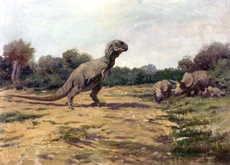 Outdated reconstruction (by Charles R. Knight), showing upright pose. |
 Replica at Senckenberg Museum, showing modern view of posture. |
- Like many bipedal dinosaurs, Tyrannosaurus rex was historically depicted as a 'living tripod', with the body at 45 degrees or less from the vertical and the tail dragging along the ground, similar to a kangaroo. This concept dates from Joseph Leidy's 1865 reconstruction of Hadrosaurus, the first to depict a dinosaur in a bipedal posture. In 1915, convinced that the creature stood upright, Henry Fairfield Osborn, former president of the American Museum of Natural History, further reinforced the notion in unveiling the first complete Tyrannosaurus rex skeleton arranged this way. It stood in an upright pose for 77 years, until it was dismantled in 1992. By 1970, scientists realized this pose was incorrect and could not have been maintained by a living animal, as it would have resulted in the dislocation or weakening of several joints, including the hips and the articulation between the head and the spinal column. The inaccurate AMNH mount inspired similar depictions in many films and paintings (such as Rudolph Zallinger's famous mural The Age of Reptiles in Yale University's Peabody Museum of Natural History) until the 1990s, when films such as Jurassic Park introduced a more accurate posture to the general public. Modern representations in museums, art, and film show T. rex with its body approximately parallel to the ground and tail extended behind the body to balance the head.
- Tyrannosaurus is the type genus of the superfamily Tyrannosauroidea, the family Tyrannosauridae, and the subfamily Tyrannosaurinae; in other words it is the standard by which paleontologists decide whether to include other species in the same group. Other members of the tyrannosaurine subfamily include the North American Daspletosaurus and the Asian Tarbosaurus, both of which have occasionally been synonymized with Tyrannosaurus. Tyrannosaurids were once commonly thought to be descendants of earlier large theropods such as megalosaurs and carnosaurs, although more recently they were reclassified with the generally smaller coelurosaurs.
- In 1955, Soviet paleontologist Evgeny Maleev named a new species, Tyrannosaurus bataar, from Mongolia. By 1965, this species had been renamed Tarbosaurus bataar. Despite the renaming, many phylogenetic analyses have found Tarbosaurus bataar to be the sister taxon of Tyrannosaurus rex, and it has often been considered an Asian species of Tyrannosaurus. A recent redescription of the skull of Tarbosaurus bataar has shown that it was much narrower than that of Tyrannosaurus rex and that during a bite, the distribution of stress in the skull would have been very different, closer to that of Alioramus, another Asian tyrannosaur. A related cladistic analysis found that Alioramus, not Tyrannosaurus, was the sister taxon of Tarbosaurus, which, if true, would suggest that Tarbosaurus and Tyrannosaurus should remain separate. The discovery and description of Qianzhousaurus would later disprove this and revealed that Alioramus belonged to the clade Alioramini. The discovery of the tyrannosaurid Lythronax further indicates that Tarbosaurus and Tyrannosaurus are closely related, forming a clade with fellow Asian tyrannosaurid Zhuchengtyrannus, with Lythronax being their sister taxon.
- Other tyrannosaurid fossils found in the same formations as T. rex were originally classified as separate taxa, including Aublysodon and Albertosaurus megagracilis, the latter being named Dinotyrannus megagracilis in 1995. However, these fossils are now universally considered to belong to juvenile T. rex. A small but nearly complete skull from Montana, 60 centimetres (2.0 ft) long, may be an exception. This skull was originally classified as a species of Gorgosaurus (G. lancensis) by Charles W. Gilmore in 1946, but was later referred to a new genus, Nanotyrannus. Opinions remain divided on the validity of N. lancensis. Many paleontologists consider the skull to belong to a juvenile T. rex. There are minor differences between the two species, including the higher number of teeth in N. lancensis, which lead some scientists to recommend keeping the two genera separate until further research or discoveries clarify the situation.
Gallery[]
Gameplay Images[]
ARK: Fear Evolved[]


